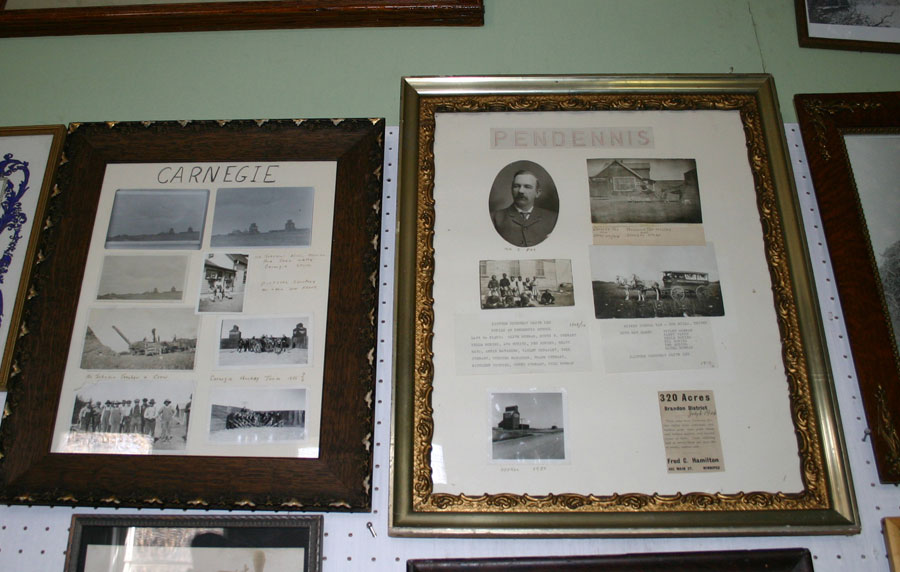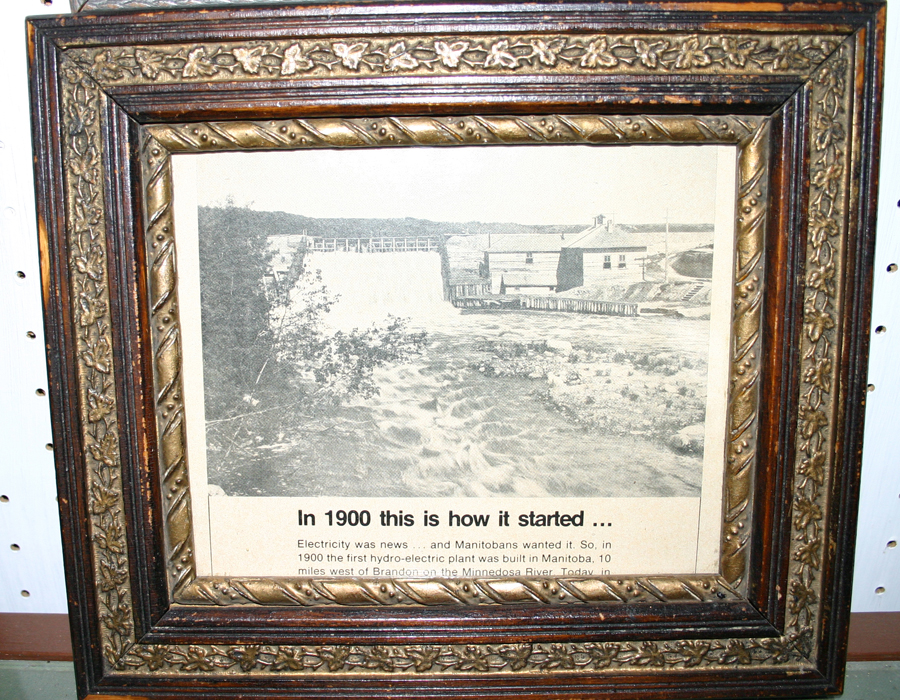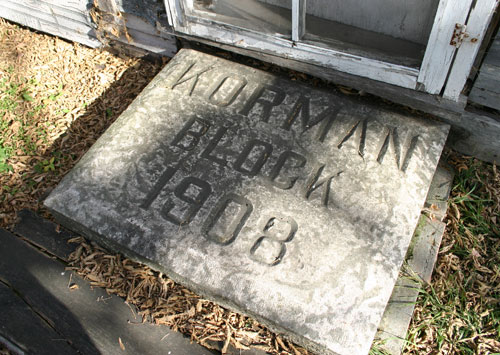
Selected Display Highlights

Residential
The
farmhouse display featured the
furnishings and appliances found a century ago in most rural homes
Although there are items that take us back to the very early pioneer
days, the bulk of the displays focus on what is often referred to as
the establishment period of rural life. The land was broken, towns and
villages appeared, and consumer goods were available. For special
items, trips to stores in the larger towns such as Rivers and even to
those in Brandon were feasible. Eaton’s Catalogue was there for
anything that couldn’t be found nearby. Sturdy frame houses, even some
in brick, had replaced the first sod huts and log cabins.
There was much in the Chapman Museum to remind us of what home life was
like in that era from 1900 to 1940.

There was furniture such this attractive and
functional kitchen
cabinets in stained wood.


This elaborate, well-designed wood burning stove would have been and
object of pride, and put to good used on a daily basis.


Fine china and glassware would be proudly put into service on special
occasions.

Items like this “boiler” would have been used in canning season or on
special occasions, gatherings etc.

An attractive clock might be prominently displayed
in the living area.

Coal oil lamps were an important item – many areas didn’t get
electricity until the late 1940’s.

This phone would have been connected to the
party line. It might
not have been a “smart “ phone but it was a giant leap forward in
communication.

Consumer Goods
The
general store displays featured an excellent collection of consumer
products that for most of us might have been long forgotten. The store
fixtures too, such as scale and cash registers belong to an era quite
removed from today’s retail experience.
Several
displays,
notably those in “Chappie’s General Store” shine a light on the
shopping experience of a century ago, and remind us that there were a
wide variety of consumer goods available to rural families, and also
that the nature of some of the staple household products has changed a
great deal while other remain almost unchanged by time.

As the first example shows names like Rogers,
Fleischman’s and Maple
Leaf Tenderflake are still with us today, the packaging changed in some
products.
It would be interesting to know what was in the container that reads,
“Imported by G.J. Jackson, Brandon, Man.” It does indicate a time when
many products were produced locally, or failing that, imported in bulk
and packaged locally.
The next photo highlights yet another brand of lard and reminds us that
Laundry Starch was once a necessary item. The right hand side of the
photo features some still- familiar breakfast cereal brands.

Lard was always necessity for baking but the
disappearance of brands
like Swifts and Burn’s Shamrock likely indicate that a greater market
share of this type of product today goes to plant-based alternatives
such as Canola Oil.

The displays featured some brands that are still
active and several
that aren’t.


And tea, then as now, comes in a wide variety of
types and brands.

As did tobacco products that, in those days were aggressively marketed
and almost universally acceptable.



The Shopping Experience
The
first stores in any community were aptly named “general” stores. For
some time they would be the only store – so they covered all the bases
by carrying everything a new settler might want. In time other retail
outlets would spring up, specializing in this or that – hardware store,
tailor shops, jewelry stores and more. In that way, today’s
“Super” stores are a return to that retailing strategy – one stop
shopping.
The most
noticeable difference was the nature of the shopping experience. It
would be some time before the self-serve format would change shopping.
Instead of roaming the aisles and selecting items to put in your cart,
you approached the counter and made your request. In the early days,
most of the food was stored in large barrels – popular items such as
sugar, soda crackers, tea biscuits, raisin biscuits, ginger snaps,
molasses, syrup, and apples. Your purchase would be placed in the
appropriate sort of bag or container by the staff. Coffee, tea
and cocoa came in large square caddies and were dispensed by the
pound. Cheese came in large round cakes and was sliced to order
with a copper wire. Cheese along with dried apples and prunes were
popular items with the numerous bachelors in a pioneer community.
As
transportation
service improved the railways brought in an increasing variety of
conveniently packaged household items. You no long just got “tea”.
Competing brands in distinctive packaging called for your attention.
For a time these were still stored on shelves behind counters, but as
time marched on the products were displayed in aisles where you served
yourself. The Chapman Museum had an extensive collection showcasing the
variety of household good that made available.
It
is also
important to note that the store was more than just a place of
business. For isolated farm families, shopping trips were social
occasions. The store was a natural meeting place.
Scales

Before everything came pre-packaged, Things were
sold by the pound or
by volume.





Product packaging became an art in itself, with
embossed glass
containers setting themselves apart from competing products.


Farm Life
Most mixed farms had milk cows, but unless they
specialized in dairy
they marketed only the cream. To do that they needed a cream separator.
The early ones were hand powered and operating them was a chore that
usually immediately followed daily milking time.

A farm machinery display highlights the start contrast with today’s
farming methods.
The very first plows carved a single furrow and most were powered by
oxen. A ten- acre field took some real time and effort.


Today self-powered combines move quickly through
large field, but the
first farmed had to bring the crop to the threshing machine.


A farmed was by necessity a repairman, advanced mechanical training was
not required but tools were essential.


School
Pioneers took education seriously. They volunteered to build schools
and often donated land for a school site. They applied for
government funding. They arranged room and board for teachers who often
came from afar and were unfamiliar with the community.

The challenge was to adapt both teaching methods and materials to the
prairie rural setting. The teacher had to be a generalist – up to eight
age/ grade levels all in one room with limited resources. By all
accounts they worked wonders, without the benefits available in a
larger school. The gymnasium was the outdoors. The library was often a
shelf in a corner, as was the science lab. (which could also be
the ourdoors).

A close-up of one such school library reveals a fine selection of what
we today call the “classics.”
At the bottom of the above photo I noticed one “classic” in particular.
Although all we can read of title is “Clearing In”, because I have that
book on the shelf, I know it to be “Clearing in The West” by Nellie
McClung. It is a very fitting selection for a rural school library.

Along with the schoolhouse display the Museum also
maintained another
building as a library.

Church
The Roseville Church was near the Chapman Farm and
was the heart of the
Roseville District. The Cemetery is still in use and maintained by
Gordon Allen.


The church was moved to the Museum after it closed
and remained as a
reminder of the importance of the Church in community life.

The Community & The Region
The nearest railway line was about 5km north of the
Chapman Farm. The
small villages of Pendennis and Carnegie were located on that line in
1902. These were important in the early days in terms of access to the
rest of the world. As they were the closest railway villages. The
stations were the link for both travel and supplies. The elevators were
where their grain was marketed. Two of the buildings featured came from
Pendennis and on came from Carnegie. Many artifacts came from these
spots as well. Prominently displayed were collections of photos from
each place – important and interesting components of the historical
record.


Southwards
along the boundary
of the municipality, Manitoba’s first hydro-electric generating station
was located on the Little Saskatchewan River. The Ten-Mile Dam, built
in 1901, was the first Hydro-Electric Generating Station in Manitoba
and supplied Brandon with its first electricity.

The dam created a lake several kilometres long. The
hydro plant ceased
operation in the 1920’s but the dam remained in place until it was
washed away by a torrent of water unleashed upstream in Minnedosa when
a dam their burst in 1948. Several photos of the plant in operation
were on display.

The Korman Block was a notable Rivers business centre and the doorstep
on display was a visual connection to the largest town in the region.

Informational displays about the original use of a
building, such as
the Pendennis School, were often part of the displays.

|